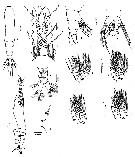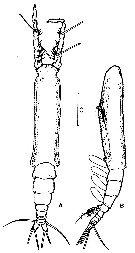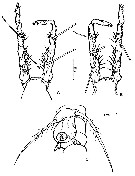|
|
 |
|
Monstrilloida ( Order ) |
|
|
|
Monstrillidae ( Family ) |
|
|
|
Monstrilla ( Genus ) |
|
|
| |
Monstrilla mariaeugeniae Suarez-Morales & Islas-Landeros, 1993 (F,M) | |
| | | | | | | Syn.: | Monstrilla wandelii tropica Suarez-Morales, 1996 (p.35, figs.M) | | | | Ref.: | | | Suarez-Morales & Islas-Landeros, 1993 (p.45, figs.F); Grygier, 1995 a (p.71); Suarez-Morales, 1998 (p.360, Rem. F,M); 2011 (p.8); Grygier & Suarez-Morales, 2018 (p.505: Rem.); Suarez-Morales & Castellanos-Osorio, 2019 (p.120). |  issued from : E. Suarez-Morales & E. Islas-Landeros in Hydrobiologia, 1993, 271. [p.47, Fig.1]. Female (from off Puerto Morelos, Yucatan): a, h, , habitus (dorsal and lateral, respectively); b, A1 (dorsal); c, P1; d, P2; i, P3; j, P4; e, genital complex (ventral); f, urosome (lateral; another specimen); g, urosome and caual rami (dorsal); k, detail of oral papilla (lateral). Nota: Cephalothorax 60 % of total body length. Oral papilla prominent, cylindrical, with small associated prominent; papilla located 42 % of way back along ventral midline of cephalic somite. Eye present, ocelli poorly developed. Cephalothorax reticulated. A1 with one articulation in proximal segment; each A1 with 4 constrictions which appear as sutures (appearing as 5-segmented). P5 fused medially, each leg with 2 distinct lobes, innerlobe (endopodal) without armature, outer lobe (exopodal) bearing 2 subequal terminal setae, each with setulae distribued along its length. Urosome consisting of 5th pedigerous, genital double-somite and 2 free somites; ratio length of genital double-somite and two free somites 62.8:17.2:20.0 = 100. Genital double-somite bearing 2 short ovigerous spiniform processes on ventral surface; spiniform process about 6 % of total body length. Caudal rami about 1.9 times longer than wide, moderately divergent, bearing 4 setae, one lateral and 3 terminal. The armature of the swimming legs is nearly the same in both species M. wandelii and M. mariaeugeniaze, but in the latter lacking an external seta on the basis of the 3rd and 4th legs (present in M. wandelii. In both species A1 show only one proximal articulation, but the 5 constrictions described for M. mariaeugeniae are not present in M. wandelii, whose A1 show a more slender and homogeneous shape. The proportional length of the A1 and the cephalic somite also differs in both species; moreover, in M. wandelii, the armature of A1 includes 3 terminal long setae on the distal portion of the last segment; in M. mariaeugeniae the A1 show no distal armature.
|
 issued from : E. Suarez-Morales & E. Islas-Landeros in Hydrobiologia, 1993, 271. [p.46 Female: Formula for armature of swimming legs.
|
 issued from : E. Suarez-Morales in Crustaceana, 1996, 69 (1). [p.36, Fig.1]. As Monstrilla wandelii tropica. Male (from off Puerto Morelos, Yucatan): A-B, habitus (dorsal and lateral, respectively). Nota: Cephalic somite plus incorporated 1st pedigerous somite almost 0.60 of total body length. Oral papilla prominent, located at 0.40 along the ventral surface of gephalothorax. Ratio of length of genital and free somites 33.6:28.7:13.3:13.4:10.89 = 100.
|
 issued from : E. Suarez-Morales in Crustaceana, 1996, 69 (1). [p.37, Fig.2]. As Monstrilla wandelii tropica. Male: A-B, A1 (dorsal and ventral, respectively); C, 5th pedigerous segment with P5, and genital apparatus (ventral). Nota: A1 0.38 of total body length, both antennulae geniculate, 5-segmented, segments 2-4 partially fused, with articulation between segments 4 and 5, 5th segment with terminal chela; length ratio ao antennular segments 11.1:16.6:23.6:23.7:25 = 100.
|
 issued from : E. Suarez-Morales in Crustaceana, 1996, 69 (1). [p.38, Fig.3]. As Monstrilla wandelii tropica. Male: A, genital apparatus (lateral); B, caudal rami (dorsal). Nota: Genital segment with a prominent genital protuberance, with a pair of genital lappets which have a bolobular structure; inner lobe rounded, with small setae on surface; outer lobe broad at base and sharpening toward its distal end. Genital apparatus 0.65 of total urosomal length. Caudal rami about 0.7 times longer than wide, bearing 1 long lateral seta and 2 well developed and 1 small terminal setae.
|
 issued from : E. Suarez-Morales in Crustaceana, 1996, 69 (1). [p.36, Fig.1]. As Monstrilla wandelii wandelii Stephensen, 1913.. Male: Armament formula of the swimming legs.
| | | | | Compl. Ref.: | | | Suarez-Morales & Gasca, 1998 a (p.112) ; Suarez-Morales, 2001 b (p.26, Rem.) | | | | NZ: | 1 | | |
|
Distribution map of Monstrilla mariaeugeniae by geographical zones
|
| | | | Loc: | | | Mexico (Reef lagoon off Puerto Morelos, Banco Chinchorro Yucatan) | | | | N: | 3 | | | | Lg.: | | | (752) F: 4,7-4,2; (753) M: 3,68; 3,56; (873) F: 3,6-4; {F: 4,20-4,70; M: 3,56-3,68} | | | | Rem.: | Sampling: 0-1.2 m.
For Suarez-Morales (1998, p.361) females are very similar to those of M. wandelii Stephensen, 1913 (cold-temperate species), but can be distinguished by the A1 structure and segmentation, body size and proportions, and the morphology of genital structures; In the case of the male M. wandelii tropica, differences were recognized in te A1 proportions, armament, and segmentation, and in the structure of the genital lappets, also the structure and shape of the caudal rami is quite similar in both sexes. Furthermore, the antennular segmentation may be sexually dimorphous, but is all the same very similar in both sexes, with only the 1st segment articulated, and the others fused. The oral papilla is located at about 45 % in posterior direction along the cephalosome. The size of females and males of M. mariaeugeniae is more than twice the corresponding sizes of M. wandelii.
For Grygier & Suarez-Morales (2018, p.505) the question of recognizing subspecies among the females was not mentioned, later Suarez-Morales (2001) synonymized male M. w. tropica with female M. elongata (Suarez-Morales, 1994) instead of M. mariaeugeniae, so the point is now mostly moot, thus, the status of M. mariaeugeniae vis à vis M. wandelii, i.e. as a separate species or subspecies remains. | | | Last update : 24/02/2020 | |
|
|
 Any use of this site for a publication will be mentioned with the following reference : Any use of this site for a publication will be mentioned with the following reference :
Razouls C., Desreumaux N., Kouwenberg J. and de Bovée F., 2005-2025. - Biodiversity of Marine Planktonic Copepods (morphology, geographical distribution and biological data). Sorbonne University, CNRS. Available at http://copepodes.obs-banyuls.fr/en [Accessed December 17, 2025] © copyright 2005-2025 Sorbonne University, CNRS
|
|
 |
 |







